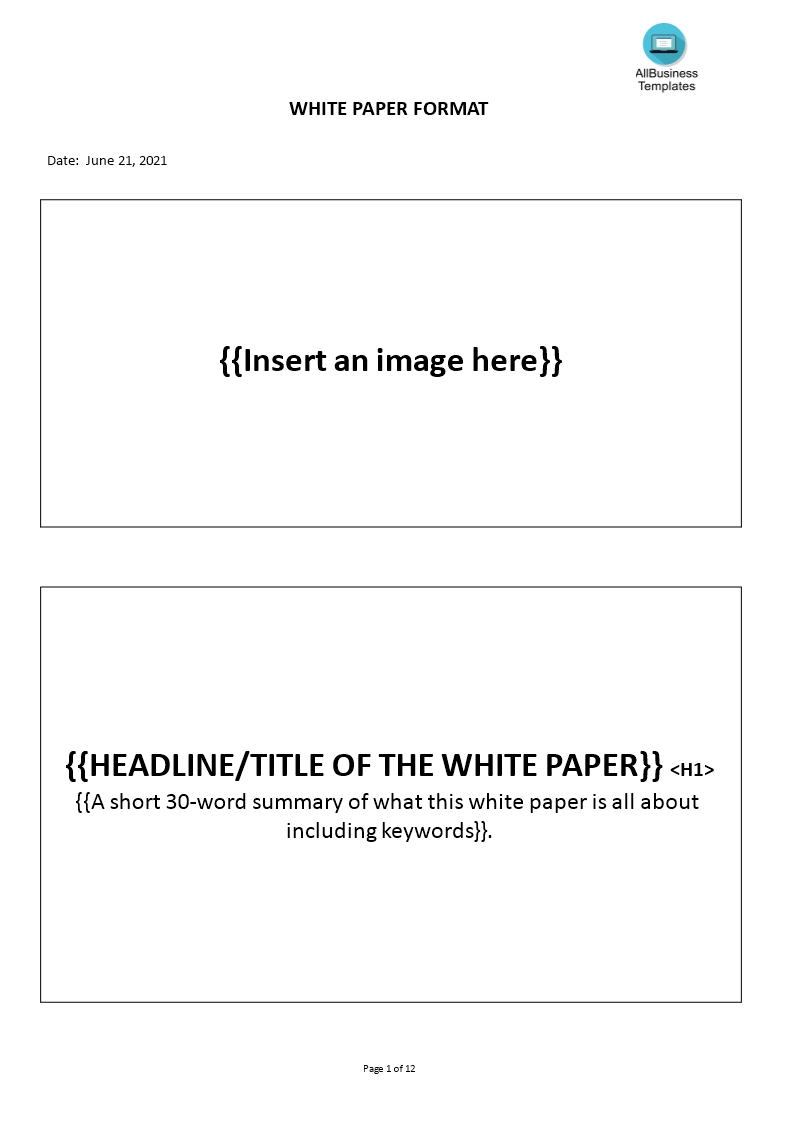White Paper Format
Save, fill-In The Blanks, Print, Done!

Download White Paper Format
Microsoft Word (.docx)Or select the format you want and we convert it for you for free:
- This Document Has Been Certified by a Professional
- 100% customizable
- This is a digital download (101.08 kB)
- Language: English
- We recommend downloading this file onto your computer.
How do you write a white paper?
A white paper in business is commonly perceived as a paper explaining a project or companies expertise in a specific field. The Whitepaper, therefore, functions as a basic summary and deeper explanation in a way a broader and generic audience, from outside the business, can understand it. This makes Whitepapers valuable to entice readers to the project or company by providing them with the best-quality knowledge of the industry.
If you follow these rules, you certainly can engage and capture your audience's attention instantaneously. Certainly, take your time to compile, edit, and proofread your Whitepaper which will benefit the audience and the efficacy of your message.
Keep the following in mind, since this is important when writing so you can deliver a professional and engaging speech:
- Reference all sources and individuals that provide input;
- Include the names of the individuals you wish to thank especially;
- Know your audience and imagine like you are your audience;
- Know the purpose of your speech, and announce in the early beginning, why you will speech;
- Use a comfortable way of writing, ideally in a formal style;
- Use clear sentences and language;
- Keep it brief and informative, without repetition;
- Edit and re-edit your Whitepaper until it’s satisfying for 100%.
We invite you to check out this Whitepaper Format which are intuitive and available in several kinds of formats, such as PDF, WORD, etc. By using our Whitepaper template, you take a head start and avoid starting from scratch. Instead, it guarantees that you will save time and effort and enables you to put more attention to the details. And details are especially important when delivering a successful paper.
White Paper Format:
The following components are included in this Whitepaper template:
- A short 30-word summary of what this white paper is all about including keywords.
- Title of the white paper
- Abstract/Executive Summary of White Paper
- Write the executive summary for the white paper in no more than 120 words.
- Table of Contents
- Insert the table of contents and the corresponding page numbers from the sub-headings of the white paper.
- Introduction
- Introduce the central theme of the white paper, its context, and why you consider this important.
- Explain Problem #1
- Now that you have introduced the white paper, explain problem area #1 in this section.
- Use numbers or graphs to explain why it is a problem area.
- Word Limit: Not more than 400 words.
- Explain Problem #2
- Now that you have introduced the white paper, explain problem area #2 in this section. Use numbers or graphs to explain why it is a problem area.
- Word Limit: Not more than 400 words.
- Explain Problem #3
- Now that you have introduced the white paper, explain problem area #3 in this section. Use numbers or graphs to explain why it is a problem area.
- It is now time to offer a solution to the problems in this section. Focus on giving enough context around your solution.
- Use this space to further explain the solution that you have proposed, its application, odds for success and expected benefits. Quantify it with charts and numbers as much as possible.
- Word Limit: Not more than 400 words.
- Case Study
- Explain your solution further with the help of a case study of how one of your clients was benefited. Begin with the problem they were facing, the solution adopted and the benefits they realized.
- Word Limit: Not more than 250 words.
- Space:
- If possible, include a quote from your customer who has implemented your solution.
- Word Limit: Not more than 20 words.
- Conclusion
- You are now ready to conclude from your white paper. Draw a conclusion that captures all the salient features of your solution and its benefits.
- About the Company
- Include a paragraph about your company, your offices, your business divisions, geographies, website etc.
Download this White Paper Format template now for your reference and impress your audience with a professional decent whitepaper!
DISCLAIMER
Nothing on this site shall be considered legal advice and no attorney-client relationship is established.
Leave a Reply. If you have any questions or remarks, feel free to post them below.
Related templates
Latest templates
Latest topics
- Drop Shipping Agreement
How to start drop shipping? Do you need a Drop shipping Agreement? Check out our Dropshipping Agreement templates now! - Google Sheets Templates
How to work with Google Sheets templates? Where to download useful Google Sheets templates? Check out our samples here. - GDPR Compliance Templates
What You Need To Be DPR compliant? Are you looking for useful GDPR document templates to make you compliant? All these compliance documents will be available to download instantly... - Christmas Templates
It's Christmas... Be prepared with nice Christmas letters, invitations, social posts etc and check out these Christmas templates now! - Excel Templates
Where to find usefl Excel templates? How do I create a template in Excel? Check these editable and printable Excel Templates and download them directly!
cheese

